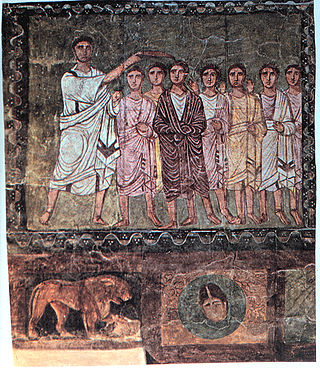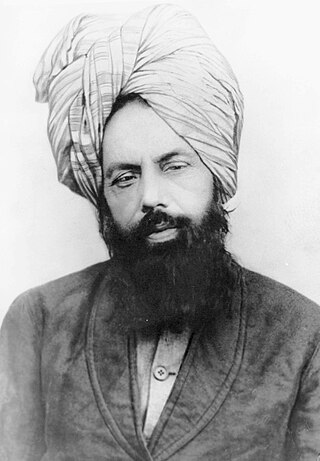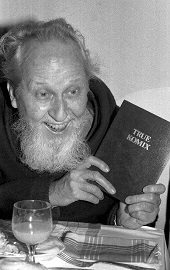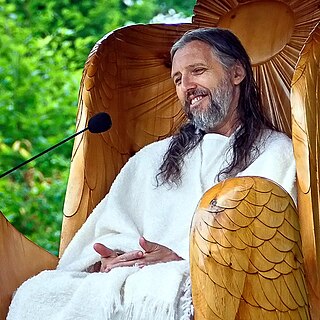This article needs additional citations for verification .(March 2014) |

Lou de Palingboer (19 February 1898 - 23 March 1968) was the founder and figurehead of a new religious movement [ which? ] in the Netherlands.
This article needs additional citations for verification .(March 2014) |

Lou de Palingboer (19 February 1898 - 23 March 1968) was the founder and figurehead of a new religious movement [ which? ] in the Netherlands.
Lou was born Louwrens Voorthuijzen in Breezand. He had a strong religious interest from an early age, probably under the influence of his devout father. He chose the profession of fisherman. After a failed marriage he met Mien Wiertz [1] and began to believe under her influence that he must save the world from the devil.
Voorthuijzen sold his boat and took up employment as an eel vendor at the Dappermarkt in Amsterdam, where he became known as Lou de Palingboer (Lou the eel vendor). From his market stall, he preached to his customers that he was "the resurrected body of Jesus Christ". He would elaborate further in a nearby café. A circle of followers formed around him. In 1954, he began holding weekly meetings in the Frascati and De Brakke Grond theatres, where he captivated his audience with a mix of mystical language and down-to-earth humour.
In 1957, a rich supporter bought a large house in Muiderberg in the municipality Muiden. They called it the "White House", and lived in it communally. His followers believed him to be a God. According to Harry Mulisch's Voer voor psychologen (Fodder for Psychologists), he claimed to be the author of the Bible. Some members of his group rejected medicine in favour of his blessing as a cure for ailments. Lou himself claimed to be immortal.
Around this time, Dutch society began to see them as a cult. Tensions frequently arose when one partner of a couple was not "in Lou" and the other one was. This resulted in a number of divorces in which Lou was summoned to testify, which he disliked. Lou moved to Agimont in the French-speaking part of Belgium to avoid summons of this kind.
After his death in Belgium in 1968, the movement seems to have dissipated. Wiertz, who moved to Spain, continues to have faith in him and there are a few other elderly believers left.

In Abrahamic religions, a messiah or messias is a saviour or liberator of a group of people. The concepts of mashiach, messianism, and of a Messianic Age originated in Judaism, and in the Hebrew Bible, in which a mashiach is a king or High Priest traditionally anointed with holy anointing oil.

Mormonism is the religious tradition and theology of the Latter Day Saint movement of Restorationist Christianity started by Joseph Smith in Western New York in the 1820s and 1830s. As a label, Mormonism has been applied to various aspects of the Latter Day Saint movement, although there has been a recent push from the Church of Jesus Christ of Latter-day Saints to distance themselves from this label. A historian, Sydney E. Ahlstrom, wrote in 1982, "One cannot even be sure, whether [Mormonism] is a sect, a mystery cult, a new religion, a church, a people, a nation, or an American subculture; indeed, at different times and places it is all of these."

In religion, a prophet or prophetess is an individual who is regarded as being in contact with a divine being and is said to speak on behalf of that being, serving as an intermediary with humanity by delivering messages or teachings from the supernatural source to other people. The message that the prophet conveys is called a prophecy.
Restorationism, also known as Restitutionism or Christian primitivism, is the belief that Christianity has been or should be restored along the lines of what is known about the apostolic early church, which restorationists see as the search for a purer and more ancient form of the religion. Fundamentally, "this vision seeks to correct faults or deficiencies by appealing to the primitive church as a normative model."

The Latter Day Saint movement is the collection of independent church groups that trace their origins to a Christian Restorationist movement founded by Joseph Smith in the late 1820s.

The Latter Day Saint movement is a religious movement within Christianity that arose during the Second Great Awakening in the early 19th century and that led to the set of doctrines, practices, and cultures called Mormonism, and to the existence of numerous Latter Day Saint churches. Its history is characterized by intense controversy and persecution in reaction to some of the movement's doctrines and practices and their relationship to mainstream Christianity. The purpose of this article is to give an overview of the different groups, beliefs, and denominations that began with the influence of Joseph Smith.

Jakob Böhme was a German philosopher, Christian mystic, and Lutheran Protestant theologian. He was considered an original thinker by many of his contemporaries within the Lutheran tradition, and his first book, commonly known as Aurora, caused a great scandal. In contemporary English, his name may be spelled Jacob Boehme ; in seventeenth-century England it was also spelled Behmen, approximating the contemporary English pronunciation of the German Böhme.

MirzāGhulām Aḥmad was an Indian religious leader and the founder of the Ahmadiyya Movement in Islam. He claimed to have been divinely appointed as the promised Messiah and Mahdī—which is the metaphorical second-coming of Jesus (mathīl-iʿIsā), in fulfillment of the Islamic prophecies regarding the end times, as well as the Mujaddid of the 14th Islamic century.

Father Divine, also known as Reverend M. J. Divine, was an American spiritual leader from about 1907 until his death in 1965. His full self-given name was Reverend Major Jealous Divine, and he was also known as "the Messenger" early in his life. He founded the International Peace Mission movement, formed its doctrine and oversaw its growth from a small and predominantly black congregation into a multiracial and international church. Due to his ideology, many consider him to be a cult leader.

David Brandt Berg, also known as King David, Mo, Moses David, Father David, Dad, or Grandpa to followers, was the founder and leader of the cult most often known as the Children of God and more recently known as The Family International. Berg's group, founded in 1968 among the counterculture youth in Southern California, gained notoriety for incorporating sexuality into its spiritual message and recruitment methods. Berg and his organization have subsequently been accused of a broad range of sexual misconduct, including child sexual abuse.

William Marrion Branham was an American Christian minister and faith healer who initiated the post-World War II healing revival, and claimed to be a prophet with the anointing of Elijah, who had come to prelude Christ's second coming; some of his followers have been labeled a "doomsday cult". He is credited as "a principal architect of restorationist thought" for charismatics by some Christian historians, and has been called the "leading individual in the Second Wave of Pentecostalism." He made a lasting influence on televangelism and the modern charismatic movement, and his "stage presence remains a legend unparalleled in the history of the Charismatic movement". At the time they were held, his inter-denominational meetings were the largest religious meetings ever held in some American cities. Branham was the first American deliverance minister to successfully campaign in Europe; his ministry reached global audiences with major campaigns held in North America, Europe, Africa, and India.

Antoine Joseph Wiertz was a Belgian painter, sculptor, lithographer and art writer. He is known for his religious, historical, and allegorical works and portraits. He was an eccentric figure who originally was much influenced by the works of Rubens and Michelangelo. Some of his works are erotic and macabre and presage Belgian Symbolism. While snubbed by contemporary art critics, he enjoyed the support of the new Belgian state, which in return for his paintings assisted him in building his personal studio/home in Brussels, where the artist worked on his art and writings as a recluse.

Sergei Anatolyevitch Torop, known as Vissarion, is a Russian spiritual teacher and founder of the non-profit, religious organization Church of the Last Testament, described by many organizations as a cult.

José Luis de Jesús Miranda was the leader of the Creciendo en Gracia cult, based in Miami, Florida. He claimed to be both the returned phase of Jesus Christ and the Antichrist; he was known for making statements that opposed the precepts of the Roman Catholic Church but that followed his interpretation of the Bible. He was previously known as el Jesucristo Hombre but shortly after his death, his followers granted him the title of Melchizedek because, as stated by his official site, he attained his new and final name which means king of justice and king of peace. Footage from one of his sermons as well as an interview with comedian Bill Maher are included in the 2008 documentary film Religulous.

Riaz Ahmed Gohar Shahi is a spiritual leader and founder of the spiritual movements RAGS International and Anjuman Serfaroshan-e-Islam.
The Surontiko Samin's challenge is an Indonesian spirituality and social movement founded by Surontiko Samin in north-central Java, Indonesia in the late 19th and early 20th centuries. Saminism rejected the capitalist views of the colonial Dutch, who predominately forced taxes upon the people of Indonesia, including the poor, and monopolized their free public forest lands; particularly land which contains precious teak forests used for trade. Samin people do not belong to the Muslim faith, and they do not practice many of the Islamic rituals such as fasting or praying. However they do focus on the spiritual aspect of all mainstream religions as well as good values, such as modesty, honesty, and simplicity.

The Victory Altar is a Christian new religious movement founded in South Korea in 1981. It teaches that Jesus Christ was a false messiah and that the real Christ is its founder, Cho Hee-Seung (1931–2004), “the Victor Christ.” The movement had some 400,000 members in the early 1990s. By 2017, however, membership declined to around 100,000. The decline came after Cho's arrest 1994 and death in 2004.
The Evangelical Association of the Israelite Mission of the New Universal Covenant is a new religious movement in Peru. They are commonly known as "Israelites" in Peru, although they are not part of mainstream Judaism. They were founded in 1968 by Ezequiel Ataucusi Gamonal, whom followers believe to be a prophet and messiah.